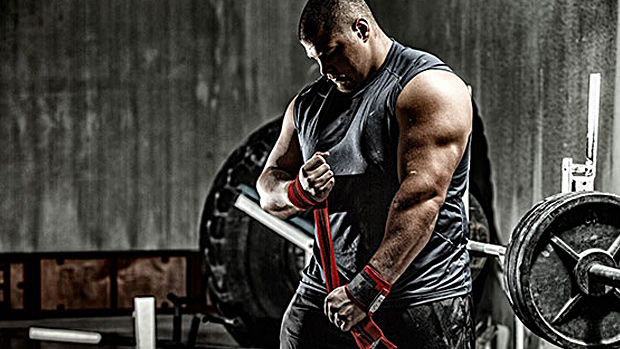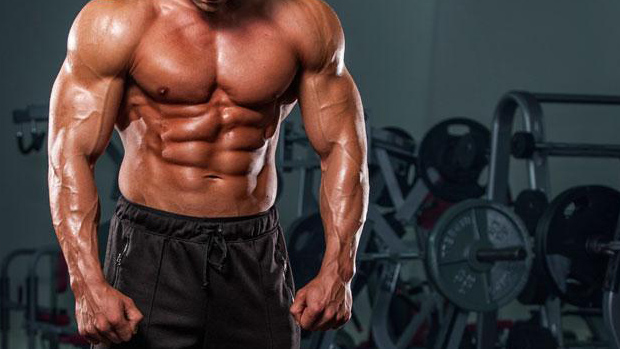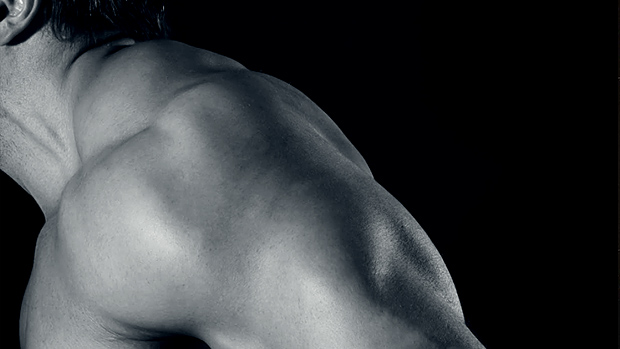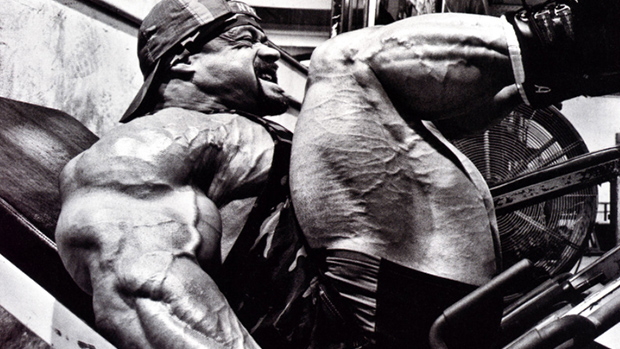Here's what you need to know...
- Large people are technically doing more work than smaller people when it comes to conditioning workouts. Rest periods need adjusted.
- Big guys with big hands will get better results and fewer joint problems using thick-grip barbells.
- Standard dip stations are too narrow. Get two Olympic bars and set them up on the pins in a squat rack.
- Big guys who suffer from chronic tightness, immobility, and pain in the joints should back off the back squats.
- Guys with big rib cages will have trouble using the standard V-grip attachment for seated rows. The small grip can force their shoulders into internal rotation.
Big Men: Train According to Your Size
It's cool being big, but it's not always easy.
For instance, having big-man shoulder width or muscle size in general can get in the way of proper form on some exercises.
Likewise, being big can raise mobility issues or require you to question training methods that are allegedly set in stone.
Here are some hard-learned lessons.
1. Sucking Wind During HIT? Use Your Own Rest Periods
High-intensity training methods are a great way to give your conditioning a kick in the pants.
However, a 270-pound guy isn't going to get the same training effect as a 185-pound guy who's doing the same program.
It's the same as thinking a 6'5" lifter is doing the same amount of work squatting his body weight to full depth as a 5'7" lifter. It just plain isn't fair to think this, because it isn't true.
The bigger dude is asking much more from his conditioning, and due to his added mass, he'll need more time to recover between bouts.
It's one reason most good triathletes don't weigh close to 200 pounds. It's also one reason to question the timed workouts of CrossFit-style workouts. The solution here is to always think outside the program sheets.
If your big-guy conditioning and cardio is being hit so hard that it's affecting the quality of your sets, or not even eliciting a partial recovery when it's time for the next set, you're probably in need of a bit more rest compared to your pencil-necked lifting partners.
But don't worry, you'll still burn fat and improve your cardio and athleticism if you submit to your need for a bit more rest.
2. Got Big Hands? Use Thick Grips for Pressing
Guys with big hands should consider using thick grip attachments or fat bars on exercises like the bench press and overhead press.
Increasing the surface area of the bar in your hand distributes the load much more evenly. More importantly, it places the load closer to the forearm – properly stacked above the wrist.
The problem is that many lifters who use a conventional thumbs-over grip will let the wrist "break" ever so slightly when carrying the loaded bar in a press position.
Lifters with larger hands are at a greater disadvantage when this happens since the bar will be positioned farther away from the wrist and forearm when they allow for this break in the wrist, simply due to the increased size of the hand.

This technically places the bar over empty space with limited support through the press. This is a reason why some big lifters enjoy using a false grip – they can place the bar much closer to the wrist despite the "risk factor" that may be associated with doing so.
As a safer recommendation, increasing the surface area of the bar (or at least the grip by way of thick grip attachments) will do more to centralize the load distribution through the hand and improve pressing strength.
As a bonus, the added bar thickness will feel better on joints and reduce unwanted stress. As a long-armed lifter, I've found fat grips very helpful, especially in the dumbbell bench press and shoulder press for heavy sets.
3. Avoid Straight Bar Curls and Chin-Ups
You have limited wrist mobility because your supination has gone to hell, thanks to your tight, jacked forearms. Why use a straight bar to do curls and chins and put all that load on the wrists?
Going old school is badass, but it can also be stupid if you're not thinking things through.
Use an EZ-curl bar or dumbbells to curl, and stick with using the suspended rings or at least a neutral or angled grip for your chins.
4. Beefy Arms? Use Straps for Front Squats
This is a known gym hack that serves guys with thick arms well, regardless of height.
Guys who are wide will have trouble gaining the requisite mobility for a proper clean-grip front squat. If they can manage to get their hands on the bar, they'll still have wrist and elbow issues as the movement progresses.

Take a pair of lifting straps and wrap them around the bar. Place the bar on your shoulders and grab those straps for security.
It allows you to hold the bar comfortably with the hands a few inches above shoulder level. It also beats the cross-armed style by a long shot. Remember to actively pull on the straps through the movement to encourage high elbows.
5. Too Wide for the Dip Station? Use a Squat Rack
I'm pretty sure you'll get a bye from gym etiquette people if you're doing dips in the squat rack when you're as wide as The Rock. (Besides, it's not like you're doing biceps curls!)
6. Rope Face-Pulls Too Constricting? Use Two Ropes
This one's simple. Instead of using a single rope, attach two rope attachments to one pulley. Presto, you've got a double-width grip that can help you retract more effectively during face pulls.
Guys who have mobility issues can also benefit from this, as a grip that's too narrow may exacerbate shoulder impingement syndrome in certain circumstances.
7. Too Wide for the Bench? Make your Back Stick like Glue
Setting up on a vinyl bench at a typical gym can be a hassle, especially if your body is too wide – or the bench is too narrow – to keep your shoulders set and pinned down.

There's no way to add width to the bench, so the next best thing is to wear a shirt that has print on the back of it. You'll find that the paint in the graphics on the back of the shirt "sticks" better to a dry vinyl bench and allows your back to catch the bench better so you don't slide.
If you haven't got a shirt like that, grab a wide band and place it flat on the bench, width-wise where your shoulder blades will lie. Instant traction. Problem solved.
8. Bad Shoulder Mobility? Back off the Back Squats!
When you carry plenty of size up top, it can create a chain reaction of tightness, immobility, and chronic pain in the joints of the arms. Oftentimes, this comes from lack of mobility at the shoulder and lack of supination ability at the wrists.
There's one thing you can do to help solve this problem, but it'll probably make you do a spit-take: Back off the back squats!
Having immobile shoulders means you have to do more work to force your hands back behind your body to lock them up on the bar, even if you use a wider grip.
It can wreak havoc on a pair of already tight shoulders and refer plenty of stress to the elbows that are forced to come along for the ride. But the answer isn't to stop back squatting altogether; just don't spend as much time under tension through lengthy sets.
If you're a big guy who's prone to these issues, use the back squat as a strength exercise and train it for lower reps. That limits the amount of time per workout that you're stuck in these positions, wrenching on your shoulders and elbows.
The weight you lift is irrelevant, but it's easier on your arms if you're doing heavy triples (where your TUT is 15 seconds per set), rather than multiple sets of 10-12 squats (where your TUT could be up to 60 seconds per set).
9. Got Wide Shoulders? Choose Wide-Grip Rows
If your ribcage is 55 inches around, it's a different ballgame compared to a guy whose ribcage is 40 inches around.
For instance, when a bigger man reaches forward at the seated row machine for a little 8-inch wide V-grip, he'll find it tougher to retract the shoulder blades because his hands and arms are angled in so much.
The big man needs more space and more width between the hands. To illustrate this, try doing a seated row motion with your fingers linked together, and then try it with your hands distanced shoulder-width apart.
The limited range of motion from a small V-grip attachment can force a big guy's shoulders into internal rotation at the end ranges of the movement, thus causing his elbows to flare out wide to compensate for a poor scapular retraction.
Ropes are a decent substitute to create more space, but some have an issue with the flimsiness compared to solid iron. It can make the grip work extra hard and take the focus off the back.

Use a pulldown bar attachment at the seated row station and do medium or wide-grip rows instead. If you can get a hold of what we call a "Suzie Bar" and use the neutral grip, it's worth its weight in gold for big guys.
The neutral grip will take you out of internal rotation and encourage greater retraction of the shoulders.
10. Bad Elbow Mobility? Use Neutral-Grip Overhead Pressing
Cutting out the strict press isn't something you need to do, but lifters tend to use the same form on their seated dumbbell presses as they use on their strict barbell presses.
Instead of flaring your elbows out, tuck them in and use a neutral grip (palms facing each other.)
That'll allow for some rotation at the shoulder and wrist, as well as enable the elbows to sit in a much more comfortable position at bottom end ranges.





